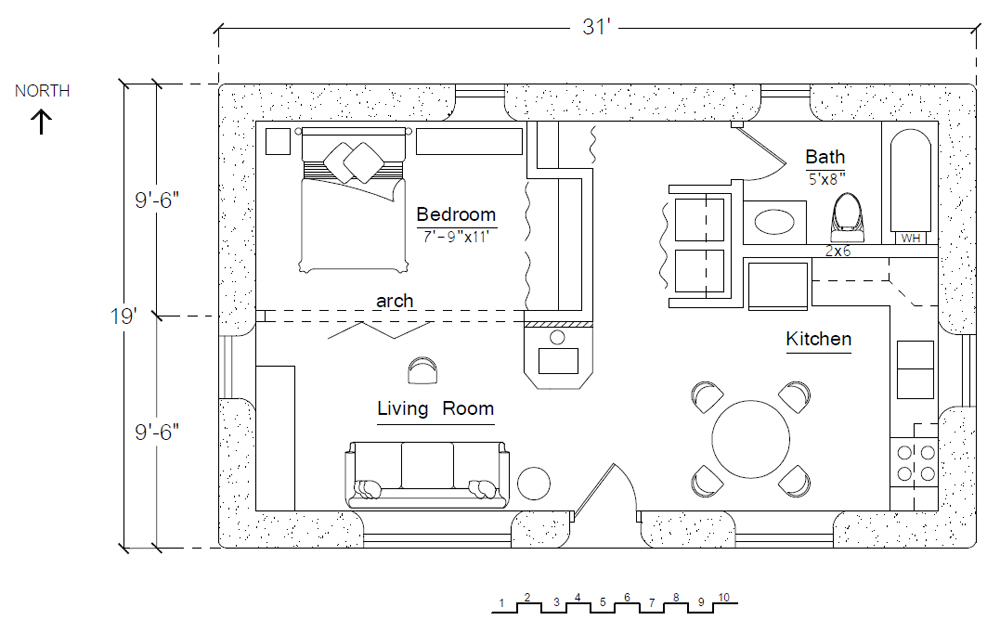
Specifications: 448 sq. ft. interior, 1 bedroom, 1 bath, Footprint: 19′ x 31′
Description: This plan is designed to be compact and efficient. Most houses this size do not have as many features — washer/dryer, wood stove, and modern kitchen and bath. There are even two closets. An archway separates the bedroom from the main living area, yet maintains a sense of privacy with a room divider.
The Economizer can be built with earthbags, straw bales, adobe, stone, cordwood, cob and other materials. Use what’s locally available and makes sense.

There are over 120 designs at Earthbag House Plans

Hello,
I love this plan and was hoping to get ahold of the CAD format to use. Is it available? Thanks for your time.
Yes, I’ll email them to you separately.
Hello! I was wondering if a basement could be added to this plan underneath if you wanted to. If so, then what would need to be done? Thank you so much.
Yes, I think that a basement could be added, and it could be done with earthbags, using somewhat larger bags for the basement. There would need to be a strong integrated bond beam at the top of the basement wall to attach floor joists to and to strengthen the wall at that point.
Looking back on this comment, I bet the underground shelter design will work if the shape was modified to fit the economizer’s shape and included an outside entry alongside an interior entry.
Yes, I would think so.
I am new to this so this may be a silly question….but lets take this plan for example. How many watts of electricity would be needed for basic needs to be met? I am trying to figure out how many solar panels I would need if I did 100% solar energy but it is looking pricy. Also, do you have any other suggestions as far as electricity for a house this size?
There’s a broad range of electricity usage. Some can get buy on a tiny panel for charging their cell phone, laptop and LED light. Others want power for TVs, stereos, dishwashers and on and on. The first rule of alternative energy is to cut your usage to the bone. Get rid of power wasters before investing in renewable energy. Use substitutes whenever possible (solar hot water heaters and ovens, wood stoves, etc. vs. electric or gas). Photovoltaic panels are pricey, but offers one of the most reliable alternatives at the moment. They last a long time, so look for used systems. And it’s good to have multiple systems if you can afford it. If your gas stove breaks, you can fire up a wood stove.
Ok thanks. We planned to do this with minimul electricity use but am finding that codes in our area are so strict and require a certain number offunctioning outlets etc. I do plan on bilding a non electric washing machine, clothes press, and of course hanging my clothess dry as well as a brick oven that is run by fire logs or coal. And did look into solar water heater. Also we will be using lots of natural light and lanterns or candles at night. I’m also looking into wind turbines and other options. But to meet code I will need to put in some sort of energy source and was wondering about options. Thanks for your time and explanation.
In the article “Earthbag Building Basics” published here (http://earthbagstructures.com/basics/basicspage.htm) you said this:
“Brace STRAIGHT WALLS every 10-12 ‘/ 3-4m with intersecting walls or buttresses.”
but from what I see opening is larger (15/28 ‘). I ask this because I have the following sketch of house (http://www.earthbag.ideipractice.ro/media/kunena/attachments/568/earthbag_house_in_gabud_05.jpg) and was wondering if it takes a buttress between the two windows on wall of 7.5 m
Thank you,
Dragos Popovici
Yes, it’s good practice to provide some sort of bracing or buttressing on long straight walls. This could include putting a post in the wall if you don’t want to use a buttress, earthbag bench, etc.
Rebar reinforcement at openings (door and windows) can solve the problem?
That will help, yes. You can play it by ear. Add extra rebar if the walls feels less stable than you’d like. I use two overlapping 5-foot pieces of rebar for standard 8 foot walls. Bond beams stiffen the walls a lot, but don’t rely just on that.
what kind of bags are used?
Our websites have hundreds of pages of info. Use the search engine in the upper right corner. My YouTube channel shows every step: http://www.youtube.com/user/naturalhouses
Step-by-step instructions: http://www.instructables.com/id/Step-by-Step-Earthbag-Building/